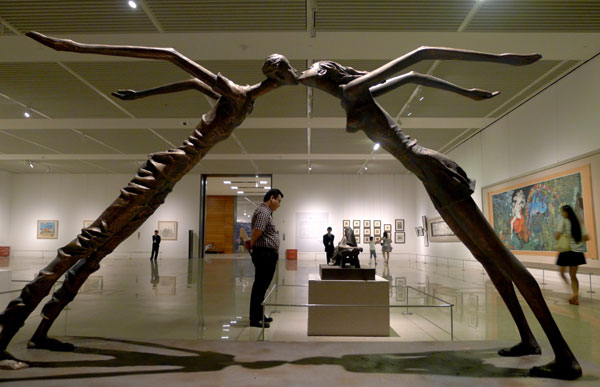Despite a growing interest in China, artworks from the country remain under-represented in the world's great galleries. Xu Jingxi chats with leading curators about how contemporary artists can take their place on the global stage.
 |
| China boasts an increasing number of world-class museums like the National Museum of China. But experts are urging these museums to play a bigger role in public art education and promote contemporary art to a broader audience. Li Wenming / For China Daily |
Chinese art lovers bemoan the fact an ink painting by Zhang Daqian, one of the world's best-known Chinese artists of the 20th century, has been lying in storage since it was collected by the New York-based Museum of Modern Art in 1961.
"Ink painting is not so important in Western art as it is in Chinese art. Zhang's Lotus is the only ink painting we have, and it's difficult to fit it into our collection," Jay A. Levenson, director of the MoMA's International Program, says of why the painting has not been displayed.
Ancient artifacts, such as china, bronzeware and jade articles, have long dominated Western art museums' exhibitions of Chinese art.
But China's rise to become a powerful voice in the global community has sparked a growing interest in Chinese contemporary art.
However, because of the late start and skyrocketing prices, the scale of collections of recent Chinese art in Western art museums is still very small.
The MoMA started seriously collecting in the late 1990s, and only has about 70 pieces of Chinese art in its collection of 100,000 items.
At a Sotheby's auction in Hong Kong on Oct 5, Beijing-based painter Zeng Fanzhi's oil painting The Last Supper was sold for HK$180 million ($23.2 million), a new record for a contemporary Asian artwork. The painting, full of absurdity and irony, was inspired by Leonardo da Vinci's medieval mural of the same name.
Aside from the prices, Western institutions are faced with a unique problem when collecting recent art from China, according to Levenson.
"Art that is old-fashioned in the West may be considered modern and contemporary in China because it was started later in the country," Levenson says.
In his opinion, the internationally recognizable contemporary art in China started after the "cultural revolution" (1966-76) when Chinese artists "had a real dialogue with Western art".
